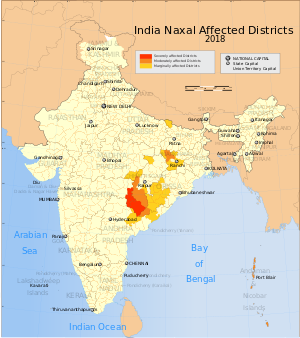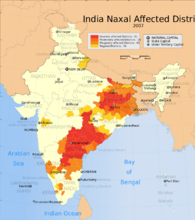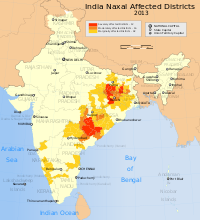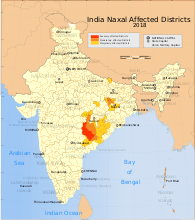العصيان الناكسالي-الماوي
| Naxalite–Maoist insurgency | |||||||
|---|---|---|---|---|---|---|---|
 Naxalite active zones in 2018, better known as the Red Corridor. | |||||||
| |||||||
| المتحاربون | |||||||
|
Militias: |
| ||||||
| القادة والزعماء | |||||||
|
Mahendra Karma † (Leader of Salwa Judum) Brahmeshwar Singh † (Leader of Ranvir Sena) |
| ||||||
| القوى | |||||||
|
|
10,000–20,000 members (2009–2010 estimate)[15][16] 10,000–40,000 regular members and 50,000–100,000 militia members (2010 estimate)[17][18] 6,500–9,500 insurgents (2013 estimate)[19] | ||||||
| الضحايا والخسائر | |||||||
| Since 1997: 2,277–3,440 killed[20][21] | Since 1997: 3,402–4,041 killed[20][21] | ||||||
|
Since 1997: 6,035–8,051 civilians killed[20][21] 1996–2018: 12,877–14,369 killed overall[22][21] | |||||||
The Naxalite–Maoist insurgency, officially referred to as the Left Wing Extremism (LWE),[23] is an ongoing conflict[24] between Maoist groups known as Naxalites or Naxals (a group of communists supportive of Maoist political sentiment and ideology) and the Indian government. The influence zone of LWE is called the Red corridor, which has been steadily declining in terms of geographical coverage and number of violent incidents, and in 2021 it was confined to the 25 "most affected" locations (accounting for 85% of LWE violence) and 70 "total affected" districts (down from 180 in 2009)[25] across 10 states in two coal rich, remote, forested hilly clusters in and around the Dandakaranya-Chhattisgarh-Odisha region and the tri-junction area of Jharkhand-Bihar and-West Bengal.[23] The Naxalites have frequently targeted tribal, police and government workers in what they say is a fight for improved land rights and more jobs for neglected agricultural laborer and the poor.[26]
The armed wing of the Naxalite–Maoists is called the People's Liberation Guerrilla Army (PLGA) and is estimated to have between 6,500 and 9,500 cadres in 2013, mostly equipped with small arms.[27][28] The Naxalites claim that they are following a strategy of rural rebellion similar to a protracted people's war against the government.[29] The insurgency started after the 1967 Naxalbari uprising led by Charu Majumdar, Kanu Sanyal, and Jangal Santhal. Their origin can be traced to the Communist Party of India (Marxist) split in 1967, leading to the creation of the Communist Party of India (Marxist–Leninist). After in-party fighting and counter-measures taken by the government, the CPI(ML) split into many smaller factions carrying out terrorist attacks mostly in the Red corridor areas.
Naxalism is largely active in tribal and rural areas of India which are remote and under-developed, and experts have advocated ethical governance, development and security as the solution.[30]
أصل الاسم
The term Naxal comes from the village Naxalbari in West Bengal where the Naxalbari uprising of 1967 occurred. People who are engaged in the insurgency are called Naxals or Naxalite. The movement itself is referred to as Naxalism.
التاريخ
الملخص
The LWE is characterised in following 3 distinct phases, "Phase 1 (1967–1973)" – the formative phase, "Phase 2 (1967–late 1990s)" – the era of spread of LWE, and "Phase 3 (2004–Current)" – relative decline after brief fightback.
منطقة النفوذ وعدد خسائر الأرواح في LWE
الرواق الأحمر – LWE affected area
LWE death count by year
As per the table below, estimated more than 13,000 people have been killed since 1996.
The first combat deaths of the insurgency were in 1980.[31] According to the Institute of Peace and Conflict studies, Naxal groups have recruited children in different capacities and exposed them to injury and death.[32] To enforce their control over the population, the Maoists have convened kangaroo courts to mete out summary justice, normally death, beatings, or exile.[33] Estimated death toll of LWE violence between 1980–2011 was 10,000 people (as per Al Jazeera),[34] including 6,000 between 1990–2010 peak of LWE (as per BBC).[35]
| Period | Civilians | Security forces | Insurgents | Total per period |
|---|---|---|---|---|
| 1996 | N/A | N/A | N/A | 156 |
| 1997 | 202 | 44 | 102 | 348 |
| 1998 | 118 | 42 | 110 | 270 |
| 1999 | 502 | 96 | 261 | 859 |
| 2000 | 452 | 98 | 254 | 804 |
| 2001 | 439 | 125 | 182 | 746 |
| 2002 | 382 | 100 | 141 | 623 |
| 2003 | 410 | 105 | 216 | 731 |
| 2004 | 466 | 100 | 87 | 653 |
| 2005 | 281–524 | 150–153 | 225–286 | 717–902 |
| 2006 | 266–521 | 128–157 | 274–343 | 737–952 |
| 2007 | 240–460 | 218–236 | 141–192 | 650–837 |
| 2008 | 220–490 | 214–231 | 199–214 | 648–920 |
| 2009 | 391–591 | 312–317 | 220–294 | 997–1,128 |
| 2010 | 626–720 | 277–285 | 172–277 | 1,177–1,180 |
| 2011 | 275–469 | 128–142 | 99–199 | 602–710 |
| 2012 | 146–301 | 104–114 | 74–117 | 367–489 |
| 2013 | 159–282 | 111–115 | 100–151 | 421–497 |
| 2014 | 128–222 | 87–88 | 63–99 | 314–373 |
| 2015 | 93–171 | 57–58 | 89–101 | 251–318 |
| 2016 | 123–213 | 65–66 | 222–244 | 433–500 |
| 2017 | 109 | 74 | 150 | 333[36] |
| 2018 | 9 | 12 | 21 | 40[37] |
| 2019 | 150 | 52 | 145 | 347[38] |
| 2020 | 134 | ؟ | ؟ | 183[39] |
| 2021 | 76 | |||
| 2022 | 63 | |||
| الإجمالي | 6,035–8,051 | 2,277–3,440 | 3,402–4,041 | 13,060–14,552[20][21][37][39] |
المسببات
انظر أسضاً
- الرواق الأحمر
- Naxalite and Maoist groups in India
- Timeline of the Naxalite–Maoist insurgency
- Scheduled Tribes in India
- Separatist movements of India
- الإرهاب في الهند
- List of terrorist incidents in India
المراجع
- ^ "Maoist Communist Centre – Left Wing Extremism, India, South Asia Terrorism Portal". Archived 12 أغسطس 2012 at WebCite. Satp.org. Retrieved 21 May 2014.
- ^ Namrata Goswami (27 نوفمبر 2014). Indian National Security and Counter-Insurgency: The use of force vs non-violent response. Routledge. pp. 126–. ISBN 978-1-134-51431-1.
- ^ "A new twist to Ranvir Sena killings". The Hindu. 20 يونيو 2000. Archived from the original on 30 أبريل 2018. Retrieved 25 ديسمبر 2017.
- ^ Narula, Smita; (Organization), Human Rights Watch (1999). Broken People: Caste Violence Against India's "untouchables". ISBN 9781564322289. Archived from the original on 25 ديسمبر 2017. Retrieved 24 ديسمبر 2017.
- ^ "Maoist gunned down in Jharkhand encounter, Jaguar official injured - the New Indian Express".
- ^ "3 People's Liberation Front of India members held for demanding levy from CMPDI officials". 2 سبتمبر 2020.
- ^ أ ب ت ث ج "Pakistan and the Naxalite Movement in India". Stratfor. 18 نوفمبر 2010. Archived from the original on 30 مارس 2018.
- ^ "A crackdown in Tamil Nadu". Frontline. 20 ديسمبر 2002.
- ^ "Maoists building weapons factories in India with help from China". India Today. 26 أبريل 2012. Retrieved 30 مارس 2018.
- ^ Stewart-Ingersoll, Robert (2012). Regional Powers and Security Orders. Routledge. p. 240.
- ^ Al Labita (22 أبريل 2010). "Philippine reds export armed struggle". Asia Times. Archived from the original on 14 أبريل 2012. Retrieved 21 مايو 2014.
{{cite web}}: CS1 maint: unfit URL (link) - ^ "Bangla Maoists involved in plan to target PM". The Sunday Guardian. 9 يونيو 2018. Archived from the original on 7 سبتمبر 2018. Retrieved 7 سبتمبر 2018.
- ^ Singh, Prakash. The Naxalite Movement in India. New Delhi: Rupa & Co., 1999. p. 24.
- ^ "Anti-Naxal operations will be intensified: CRPF chief Pranay Sahay". Indiatimes. 11 يناير 2013. Archived from the original on 23 مايو 2013. Retrieved 31 مارس 2013.
- ^ Srivastava, Mehul (29 يوليو 2010). "Maoists in India Blow Up Pipelines, Putting $78 Billion at Risk". Bloomberg. Archived from the original on 2 أغسطس 2010.
- ^ "Indian police battle Naxalites". Al Jazeera English. Archived from the original on 17 ديسمبر 2009. Retrieved 26 أكتوبر 2014.
- ^ خطأ استشهاد: وسم
<ref>غير صحيح؛ لا نص تم توفيره للمراجع المسماةcsis.org - ^ "India's Failing Counterinsurgency Campaign". Archived 23 أكتوبر 2014 at the Wayback Machine. Foreignpolicy.com. Retrieved 21 May 2014.
- ^ "India faces internal challenge from Maoist-Naxalites". Thefinancialexpress-bd.com. Archived from the original on 3 يونيو 2015. Retrieved 26 أكتوبر 2014.
- ^ أ ب ت ث "Fatalities in Left-wing Extremism: 1999–2016* (MHA)". Archived from the original on 8 أكتوبر 2017. Retrieved 26 أكتوبر 2014.
- ^ أ ب ت ث ج "Armed Conflicts Report – India-Andhra Pradesh" (PDF). Ploughshares. Archived (PDF) from the original on 18 مارس 2009. Retrieved 17 مارس 2009.
- ^ See table below.
- ^ أ ب خطأ استشهاد: وسم
<ref>غير صحيح؛ لا نص تم توفيره للمراجع المسماةurb1 - ^ "India's Naxalites: A spectre haunting India". The Economist. 12 أبريل 2006. Archived from the original on 23 مايو 2010. Retrieved 13 يوليو 2009.
- ^ "Press Information Bureau". Retrieved 1 أبريل 2015.
- ^ "CENTRAL/S. ASIA – 'Maoist attacks' kill Indian police". Al Jazeera English. 15 مارس 2007. Archived from the original on 13 يوليو 2009. Retrieved 13 يوليو 2009.
- ^ Uppsala Conflict Data Program, Conflict Encyclopedia, India: government, Government of India – CPI-Maoist, Actor Information, CPI-Maoists, viewed 2013-05-29,http://www.ucdp.uu.se/gpdatabase/gpcountry.php?id=74®ionSelect=6-Central_and_Southern_Asia# Archived 3 فبراير 2013 at the Wayback Machine
- ^ "Primer: Who are the Naxalites?: Rediff.com news". Us.rediff.com. Archived from the original on 4 مايو 2009. Retrieved 13 يوليو 2009.
- ^ "Communists Fight in India « Notes & Commentaries". Mccaine.org. Archived from the original on 27 يوليو 2011. Retrieved 13 يوليو 2009.
- ^ "'There is only one way of solving Naxalism and that is ethical security and ethical governance'". Times of India Blog (in الإنجليزية الأمريكية). 2 سبتمبر 2019. Retrieved 30 يوليو 2021.
- ^ "India's Maoists offer ceasefire". BBC News. 22 فبراير 2010. Archived from the original on 25 فبراير 2010. Retrieved 20 مايو 2010.
- ^ خطأ استشهاد: وسم
<ref>غير صحيح؛ لا نص تم توفيره للمراجع المسماةn1 - ^ Loyd, Anthony (2015). "India's insurgency". National Geographic (April): 95. Archived from the original on 1 أكتوبر 2018. Retrieved 13 مارس 2018.
- ^ Al Jazeera Correspondent. "India's Silent War". Archived from the original on 9 نوفمبر 2011. Retrieved 26 أكتوبر 2014.
- ^ Bhaumik, Subir (10 فبراير 2010). "India's Maoists 'ready for talks'". BBC News. Archived from the original on 1 يوليو 2010. Retrieved 20 مايو 2010.
- ^ "Fatalities in Left-wing Extremism: 2017". South Asian Terrorism Portal. Archived from the original on 4 يناير 2018. Retrieved 2 يناير 2018.
- ^ أ ب "Fatalities in Left-wing Extremism: 2018". South Asian Terrorism Portal. Archived from the original on 3 مارس 2017. Retrieved 10 يناير 2018.
- ^ "MHA data shows major dip in Maoist violence across country". Deccan Herald (in الإنجليزية). 12 فبراير 2020. Retrieved 20 أكتوبر 2021.
- ^ أ ب Deaths in Maoist attacks down by 21%, Times of India, Sept 2021.
للاستزادة
- Mukherjee, Shivaji (2021). Colonial Institutions and Civil War: Indirect Rule and Maoist Insurgency in India. Cambridge University Press.
- Verghese, A. (2016). "British Rule and Tribal Revolts in India: The curious case of Bastar." Modern Asian Studies, 50(5), 1619–1644.
- Walking with the Comrades
وصلات خارجية
- Naxal insurgency in India, CivilServiceIndia.com.
- Data on Naxalite-Maoist Insurgency fatalities in India, Institute for Conflict Management (South Asia), SATP.
- The political economy of the Maoist conflict in India : an empirical analysis, Joseph Gomes (2012), University of Madrid, Spain.
- Hearts and mines: A district-level analysis of the Maoist conflict in India, Kristian Hoelscher et al., University of Oslo, Norway, DOI:10.1177/2233865912447022.
- Targets of Violence: Evidence from India’s Naxalite Conflict Oliver Vanden Eynde (2013), Paris School of Economics.
- India’s Naxalite Insurgency: History, Trajectory, and Implications for U.S.-India Security Cooperation on Domestic Counterinsurgency by Thomas F. Lynch III – Institute for National Strategic Studies.
- CS1 maint: unfit URL
- CS1 الإنجليزية الأمريكية-language sources (en-us)
- Short description matches Wikidata
- Use dmy dates from November 2021
- Articles with hatnote templates targeting a nonexistent page
- التمرد الناكسالي-الماوي
- نزاعات القرن العشرين
- القرن العشرون في الهند
- نزاعات القرن 21
- القرن 21 في الهند
- تاريخ جمهورية الهند
- Operations involving special forces
- Communism-based civil wars
- حروب أهلية قائمة على ثورات
- Rebellions in India
- Far-left terrorism
- Far-left politics
- Far-left politics in India
- إرهاب
- Terrorism in India
- نزاعات عقد 1970
- نزاعات عقد 1980
- نزاعات عقد 1990
- نزاعات عقد 2000
- نزاعات عقد 2010
- نزاعات عقد 2020
- Communist repression
- حروب الهند
- ارهاب شيوعي
- تمردات دائرة
- Insurgencies in Asia
- حروب بالوكالة


